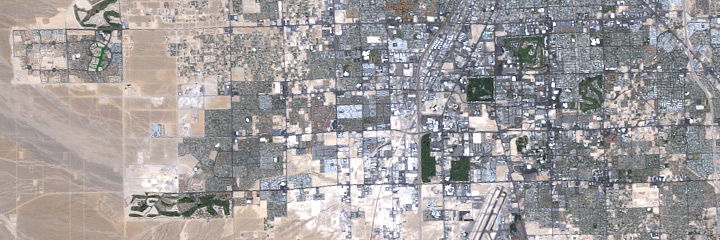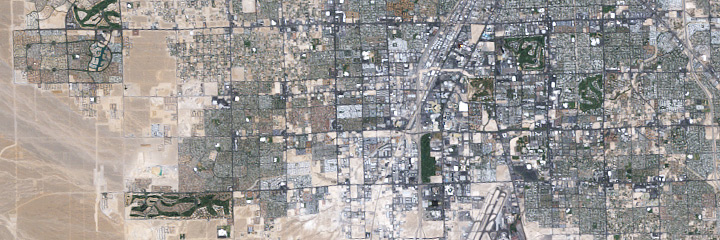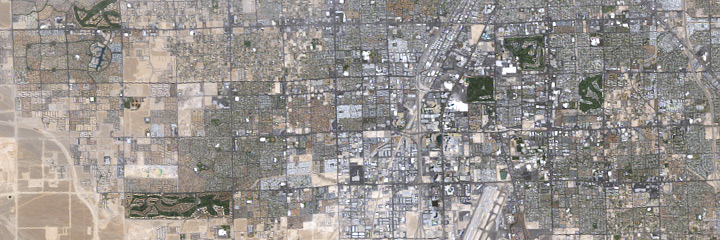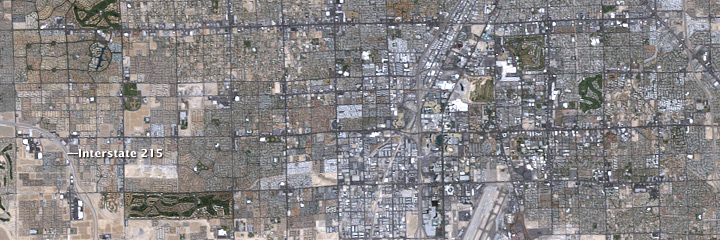





25 Years of Growth in Las Vegas
Downloads
- vegas_tm5_1984_lrg.jpg (2149x2150, JPEG)
- lasvegas_tm5_22oct84_crop_geo.tif (2150x2150, GeoTIFF)
- vegas_tm5_1989_lrg.jpg (2149x2150, JPEG)
- lasvegas_tm5_29may89_crop_geo.tif (2150x2150, GeoTIFF)
- vegas_tm5_1994_lrg.jpg (2149x2150, JPEG)
- lasvegas_tm5_28jun94_crop_geo.tif (2150x2150, GeoTIFF)
- vegas_tm5_1999_lrg.jpg (2149x2150, JPEG)
- lasvegas_tm5_09may99_crop_geo.tif (2150x2150, GeoTIFF)
- vegas_tm5_2004_lrg.jpg (2149x2150, JPEG)
- lasvegas_tm5_07jun04_crop_geo.tif (2150x2150, GeoTIFF)
- vegas_tm5_2009_lrg.jpg (2149x2150, JPEG)
- lasvegas_tm5_12jan09_crop_geo.tif (2150x2150, GeoTIFF)
- ge_37228.kml (KML)
Metadata
- Sensor(s):
- Landsat 5 - TM
- Data Date: October 22, 1984 - January 12, 2009
- Visualization Date: February 26, 2009
On March 1, 2009, NASA’s Landsat 5 satellite turned 25. Originally intended to last just three years, the satellite exceeded its life expectancy by 22. Although Landsat 5 needed the occasional software fix to continue functioning, by March 2009, it had provided images of our planet for a quarter of century.
With a resolution of roughly 30 meters (100 feet) per image pixel, Landsat 5’s Thematic Mapper does not detect objects as small as individual houses or trees, but the sensor can detect land use changes, including forest clearing, replanting, and urbanization, over a wide area. Las Vegas, Nevada, provides an example of the sensor’s ability to monitor change over time. The Thematic Mapper captured these true-color, photo-like images on (top to bottom) October 22, 1984; May 29, 1989; June 28, 1994; May 9, 1999; June 7, 2004; and January 12, 2009.
These images of the western portion of the Las Vegas metropolitan area show the city’s steady spread into the adjacent desert landscape. Undeveloped land appears along the left edges of the top two images. Here, the land on the city’s outskirts appears in shades of beige and tan, with just a hint of the street grid to come. By 1989, however, development filled the upper left corner—a residential area, complete with curving roads and semicircle streets. In subsequent images, development spreads southward, and by 2004, the entire image shows cityscape, including Interstate 215 passing through southwestern portion of the city.
In these images, buildings and paved areas appear in shades of gray or beige, the clearest example being the McCarran International Airport near the bottom center of each image. Meanwhile, the occasional park or meandering golf course appears green-brown. Perhaps the most conspicuous golf course appears in the lower left of each image. The course was still being developed in 1984, but appeared complete in later shots. In the 2009 image, grassy areas appear less intense in color, and their lighter hues likely result from the time of year that Landsat acquired the image. In the same image, patches of dark colors appear along the Las Vegas strip, thanks to tall buildings casting their shadows toward the northwest.
As these images suggest, Las Vegas experienced rapid growth between 1984 and 2009. Building and maintaining a city in a desert raises challenges for meeting the resident’s water needs, and by the early 2000s, city officials had begun recycling wastewater and paying residents to remove thirsty grass lawns.
-
References
- Bernstein, R. (2008, March 27). Dallas-Fort Worth leads metro areas in numerical growth. U.S. Census Bureau. Accessed February 27, 2009.
- Hansen, K. (2009, March 2). Earth Observing Landsat 5 Turns 25. NASA Goddard Space Flight Center.
- Quirk, B.K. (2008). Landsat 5: Celebrating 25 Years. Earth Imaging Journal. 5(6), 12-14.
- Tanner, A. (2007, August 21). Las Vegas growth depends on dwindling water supply Reuters. Accessed February 27, 2009.
NASA images by Jesse Allen and Robert Simmon, based on Landsat 5 data from the USGS Global Visualization Viewer. Caption by Michon Scott.
This image record originally appeared on the Earth Observatory. Click here to view the full, original record.